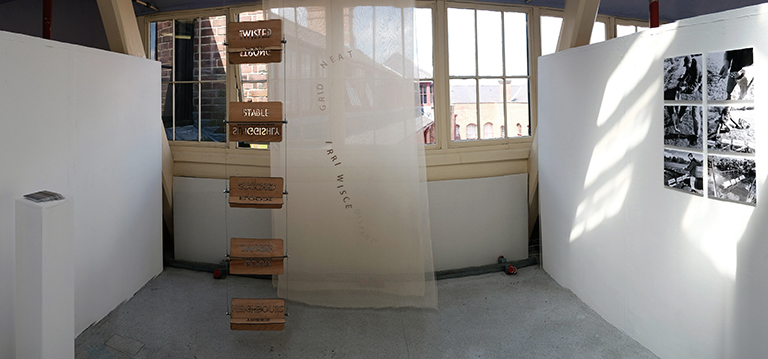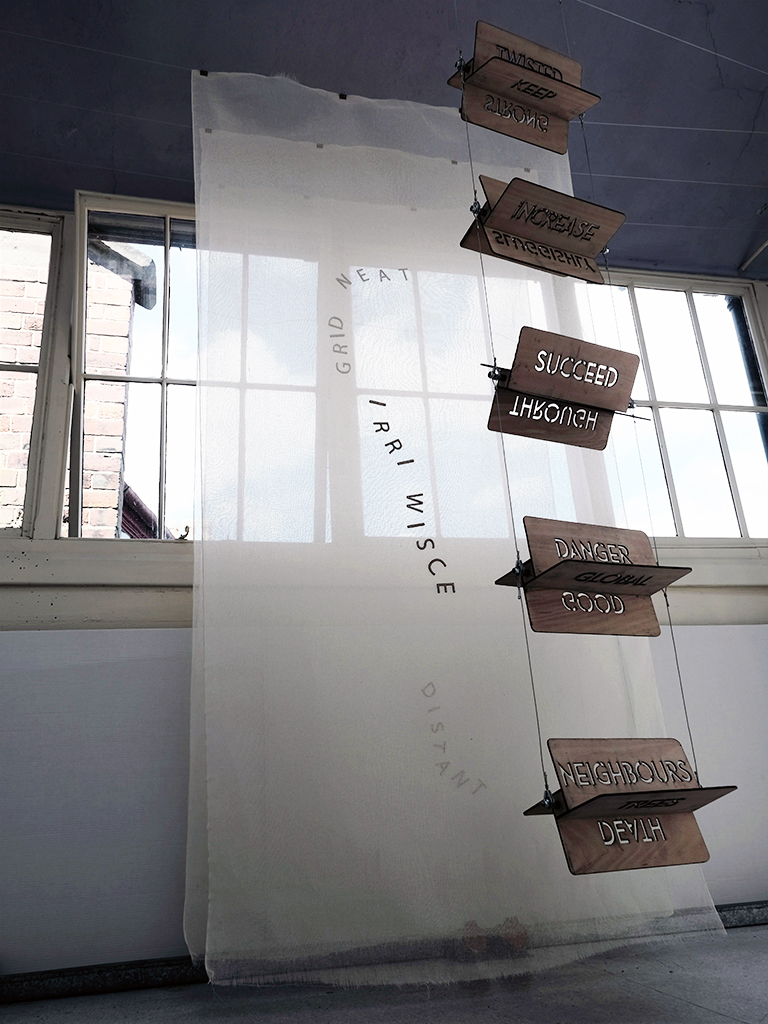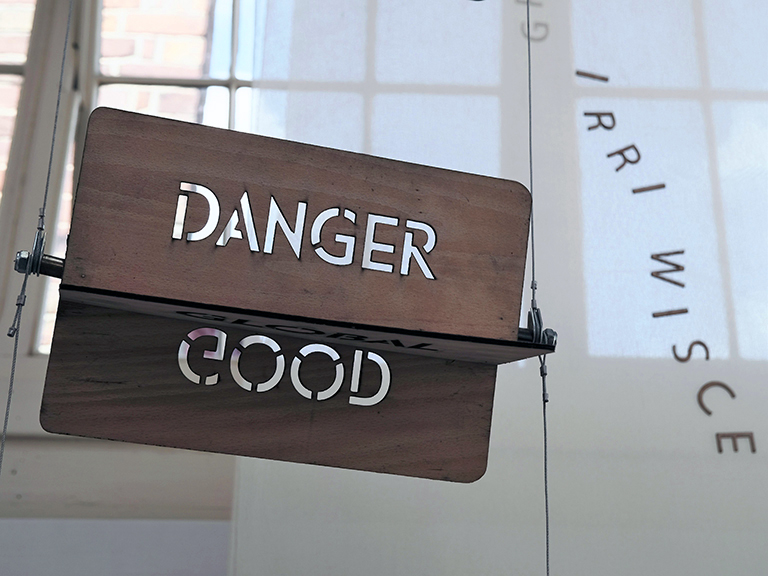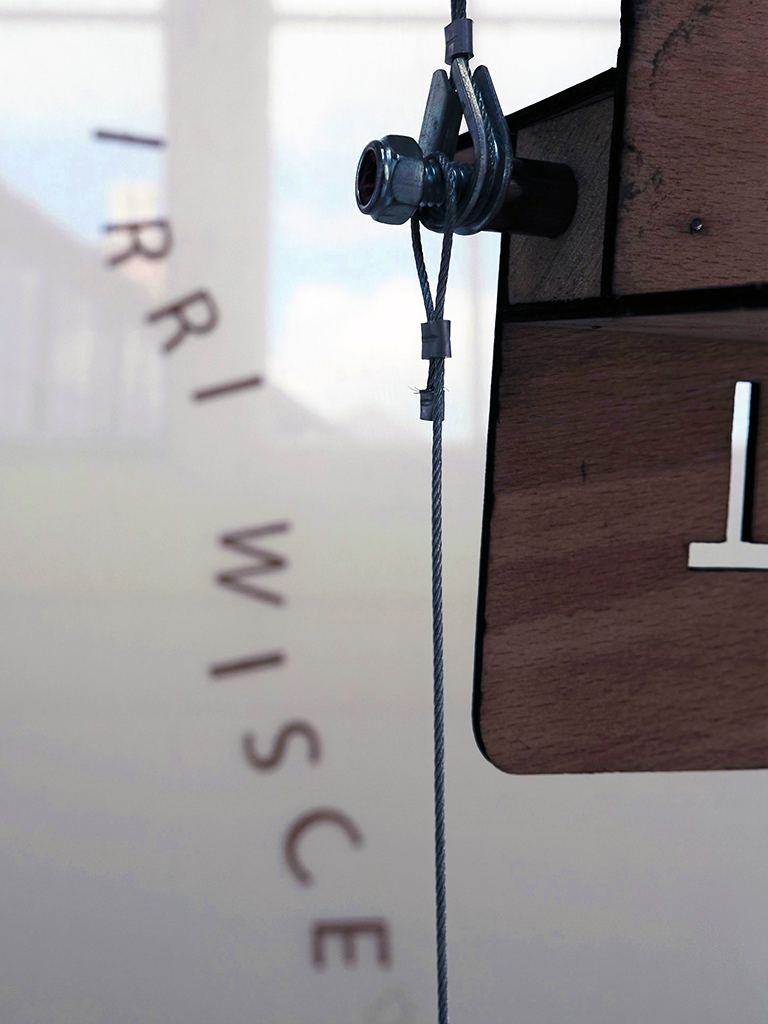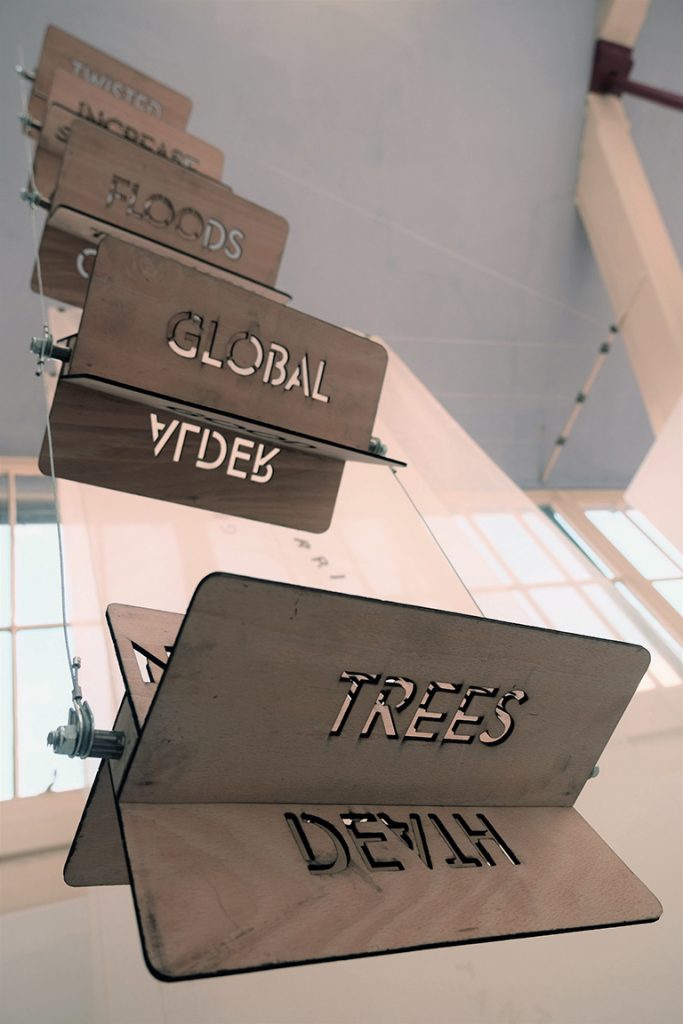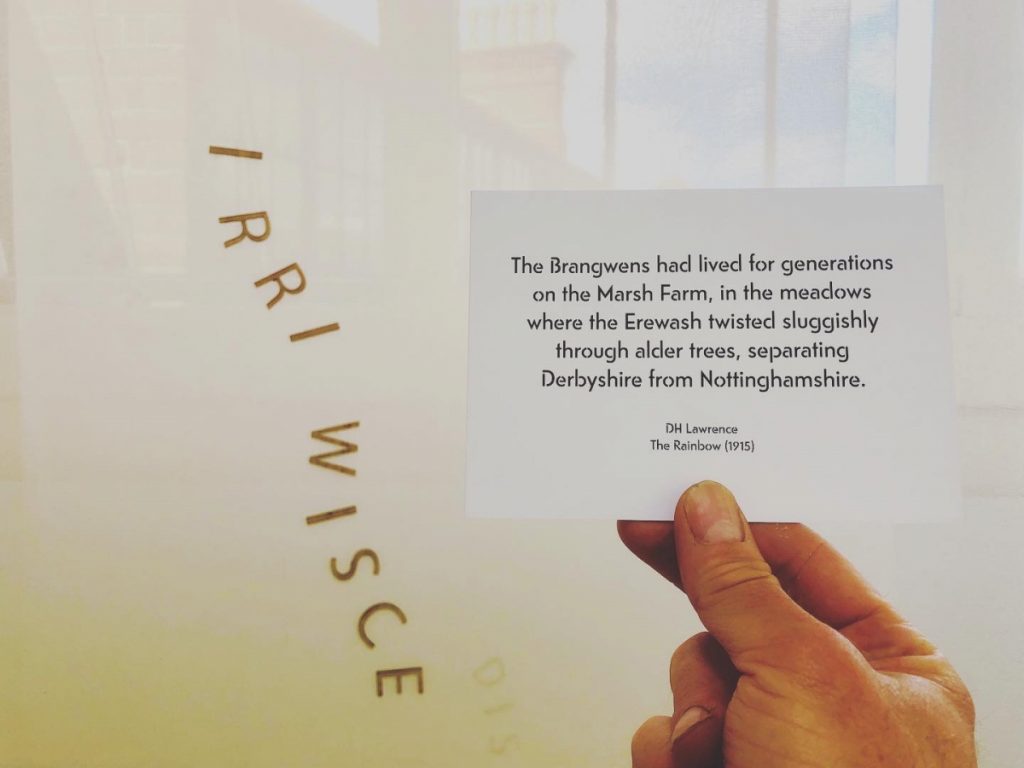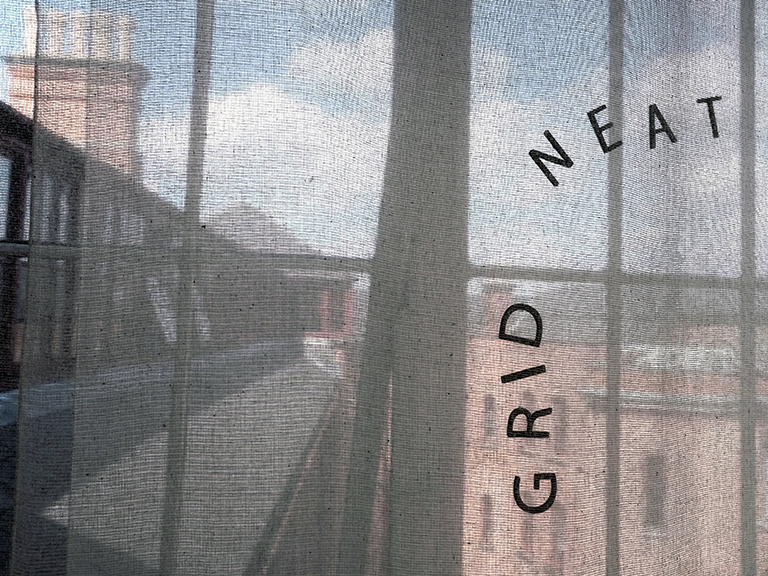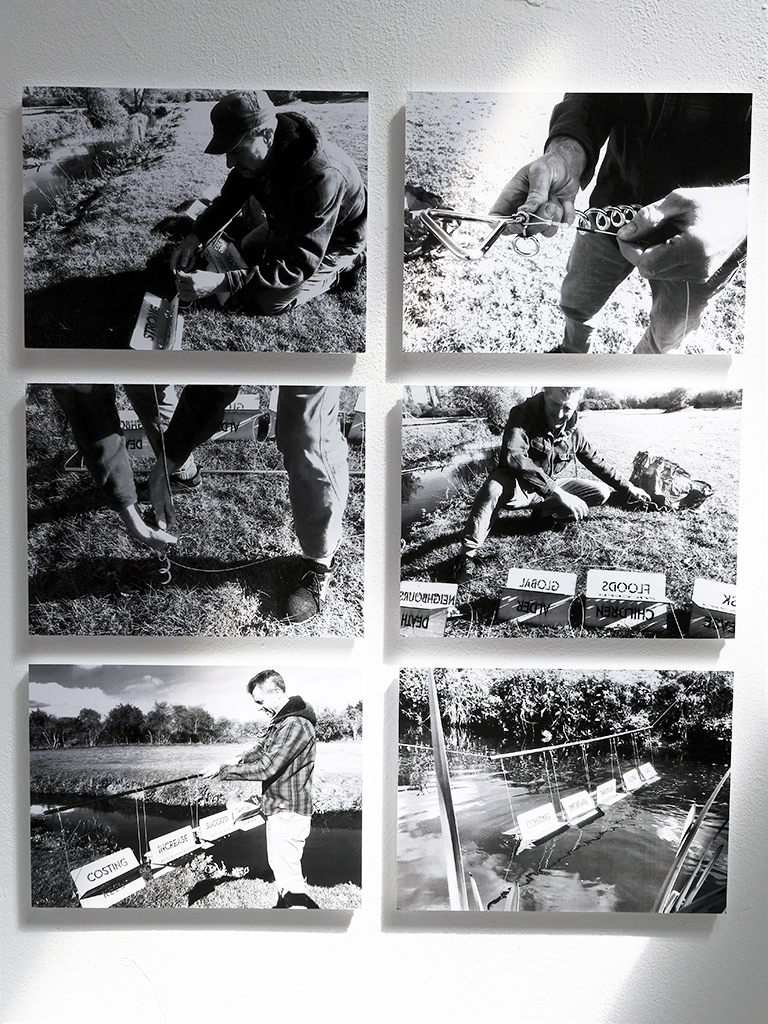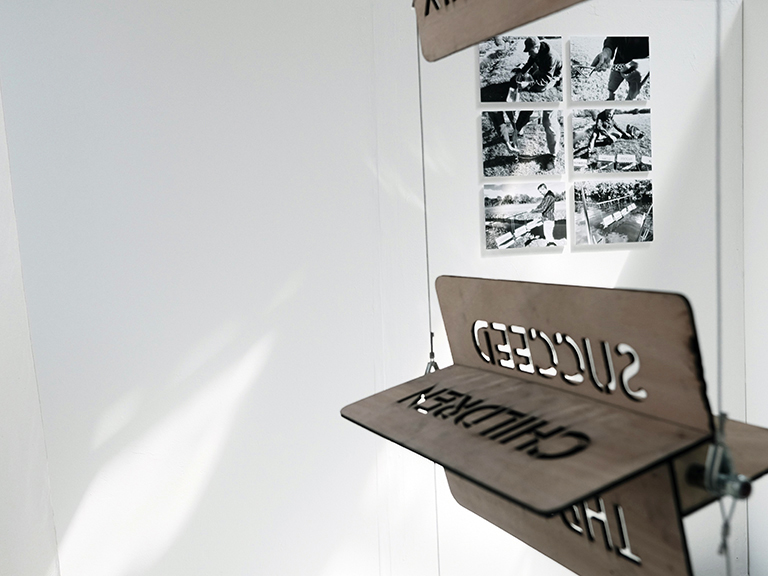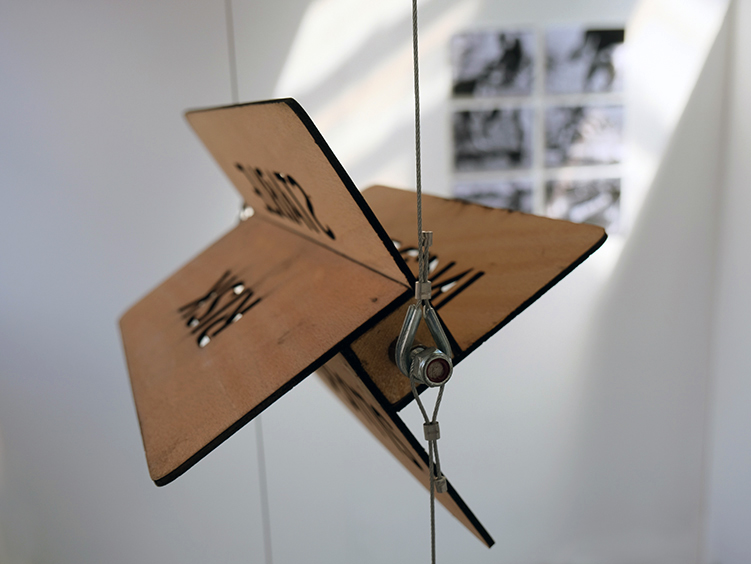Index
Artist statement
Final outcome
Starting point
Primary research strategy
Concept
Materials
Health and safety
Artist inspiration
Experimental development
Evaluation
Future potential
Artist statement
Richard Hyde
Irre Wisce, 2021
Plywood, metal hardware, cloth, photographs
The River Erewash (Irre Wisce in old English) forms the county border between Nottinghamshire and Derbyshire and since the industrial revolution, it has been poisoned with toxic waste, rendered devoid of life and culverted out of sight to make way for countless waves of transport infrastructure. But in stark contrast, this beautifully sinuous river has provided inspiration for world-renowned writers, poets and naturalists as it steadfastly and obliviously meanders its way south. In this piece, the artist has explored how the descriptive language humans have attached to the River Erewash has mirrored the meandering curves of the watercourse itself in how it has ebbed and flowed between romantic reverence and political rhetoric. We are asked to consider how our physical distance from natural beauty impacts our perception of it as either a precious place of solace or as an obstruction to human enterprise.
Final outcome
We see an installation in a booth that includes a vertically suspended set of five rotating wooden waterwheel-like structures, connected by wires. This structure affirmatively dominates the space and has signs of environmental wear and tear. Each wooden wheel has four paddles attached to the central spindle and each paddle has a word that is laser cut out of it in a bold stencil font. These words appear disconnected in meaning and seem to reference a mixture of political and poetic language. As the wooden paddles turn it is clear that unique combinations of words will be formed.
Behind the hanging wooden structure are a number of semi-transparent hanging cream sheets, each with words attached that have been created from wooden letters. These words follow a curved path which could be the sinuous path of the course of a river. The words themselves are a mix of descriptive and poetic language that overlay each other on the shimmering material.
On one wall of the booth, we see a set of six black and white photographs showing an activity taking place on the bank of a river. The paddles have clearly participated in a historical event. They have been constructed on a riverbank, suspended over the river and turned under the force of the river current. We now appreciate that the wear and tear on the paddles is likely due to the historical event of them being in the river.
Finally, we see a stack of postcards on a plinth with a graduated set of colours on one side and a QR code that links to the video clip below of the paddles turning on the river. On the other side is a paragraph from The Rainbow by DH Lawrence which poetically describes the meandering nature of the River Erewash.
Starting point
I have lived around the river Erewash for the past 25 years, I’ve crossed it hundreds of times, I’ve run up and down it, biked along it and I’ve canoed down it. It has become a silent but familiar part of my life that I (and I suspect most people) just take for granted as a geographical boundary between Derbyshire and Nottinghamshire. This project began with a desire to better appreciate the scale, geography and impact of this river on local people over history. I was interested in how humanity has exploited and revered this river, often in parallel. I was also intrigued by the political and poetic language that has been thrown at this innocent watercourse to suit the polar opposites of man’s emotional and exploitative desires. My proposal details how I laid out my plan for the project.
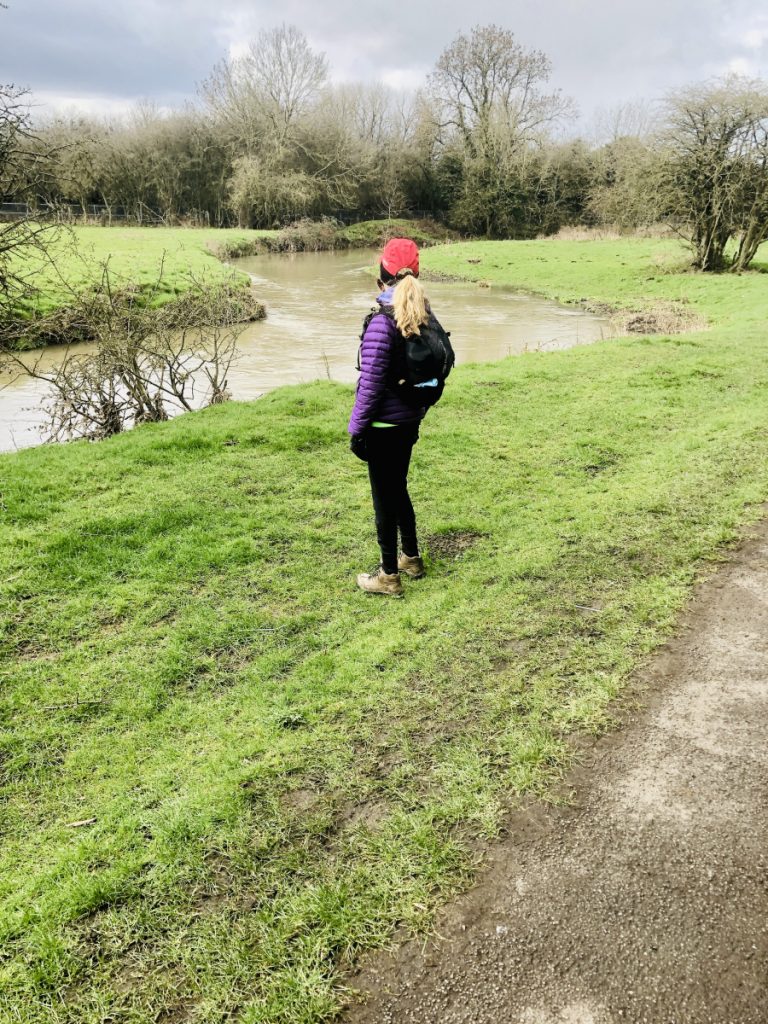
Primary research strategy
My primary research strategy was to walk the entire length of the river and record the experience and gather materials where appropriate. I felt this was central to the whole project as I had to see how the water passed through the landscape, how that landscape changed and what natural/unnatural barriers were encountered. At 25 miles long this was achievable over 3 separate visits and I decided to record video and collect mud samples at 1-mile intervals along the entire course.

I also investigated the history of the River Erewash through online documentation I could find relating to its mention in political, cultural and geographical records. This revealed a rich combination of information that highlighted the extraordinary historical challenges thrown at this innocent river and the threats to it in the near future. This included industrial pollution and rerouting of the river to make way for the M1 in the late 1960s plus the planned rerouting for the proposed Hs2 route through the East Midlands.
Online workshops and conferences were also a useful source of knowledge related to contemporary land art and psychogeography. In particular, I attended an online conference entitled ‘Walking & running as art practice’ which was useful guidance in how to extrapolate thoughtful art from being in a landscape. I also listened to the Street Wisdom event organised by the Creative Mornings group which highlighted the importance of ‘tuning in’ to a landscape to get the most back from it – very useful knowledge to take forward to my project.
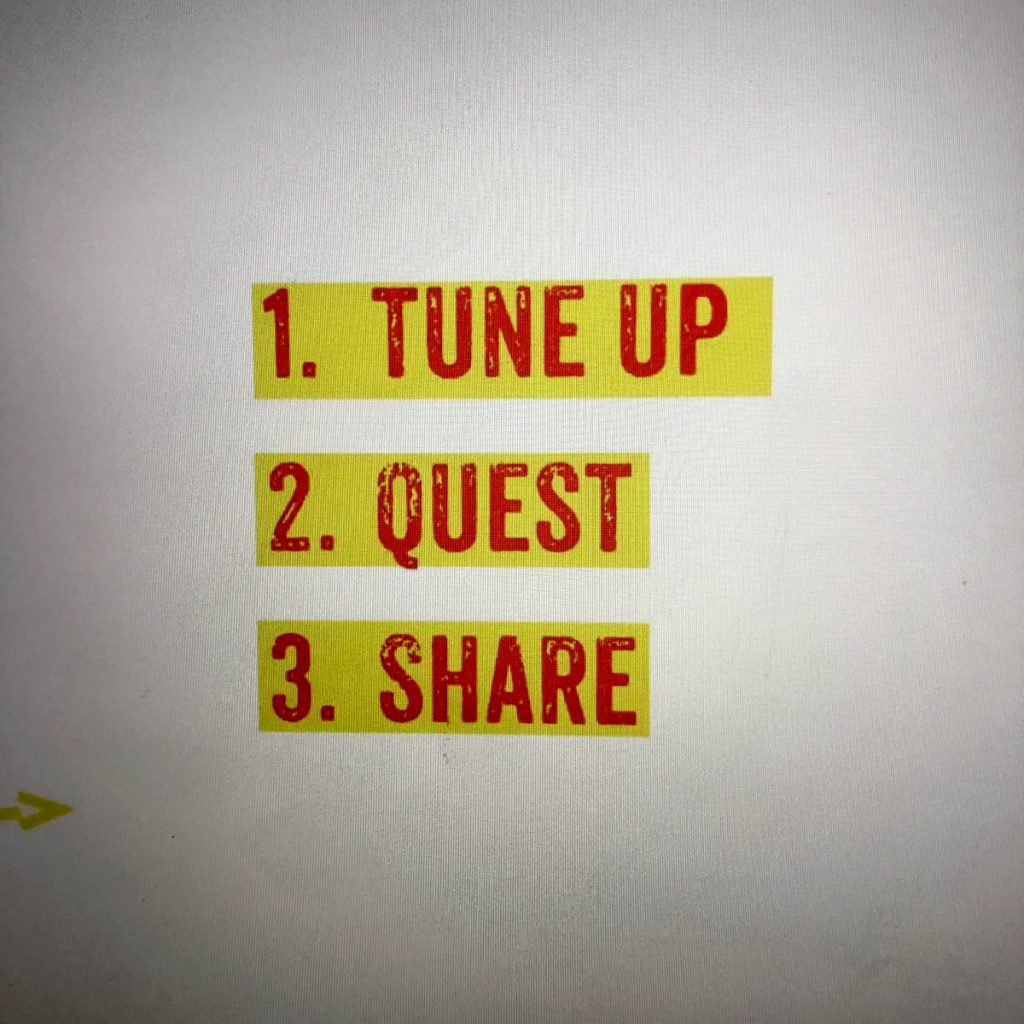
Concept
At the outset, I decided that this project would have an environmental awareness undercurrent but I was keen to find a unique angle to tease out something previously undiscovered about how and why we mistreat the UK landscape. Language continues to fascinate me and I found the disparity of language used to describe the River Erewash used by bodies with different vested interests quite fascinating. Therefore, this was the concept I pursued, an investigation of historical and contemporary language connected with the River Erewash and illumination of how and why this changes.
Materials
This project has primarily been an engineering task so the final outcome employs plywood, steel hardware and wire. Earlier in the project, I also experimented with perspex and other man-made materials for the water wheels but plywood had an aesthetic appeal that was more appropriate. I collected mud along the course of the river as inspiration and this helped create a colour palette for part of the final outcome. I also captured and edited countless video clips as I walked the course of the river and even though these didn’t appear in the final piece they formed an invaluable collection of my thoughts and insights on the journeys I undertook.
Health and safety
The engineering tasks were carried out with careful planning and with appropriate tools and safety wear so did not present many safety concerns. Working in and around the River Erewash was a minor concern but more so for the impact on the wildlife on the river. With this in mind, I chose areas carefully to avoid any obvious bird habitats and kept a careful eye on encroaching wildlife while the live installation took place. I also kept the installation in place for a minimal amount of time to minimise impact.
Artist inspiration
Artists who use glorious mud formed my first set of inspirations and they included the work of Nick Rands, John Newling and Stephen Turner. Rand’s mud balls below was an astounding find and this inspired my own mud collection. This collection seems to show epochs of earth’s history and made me want to go out and study mud with fresh eyes.
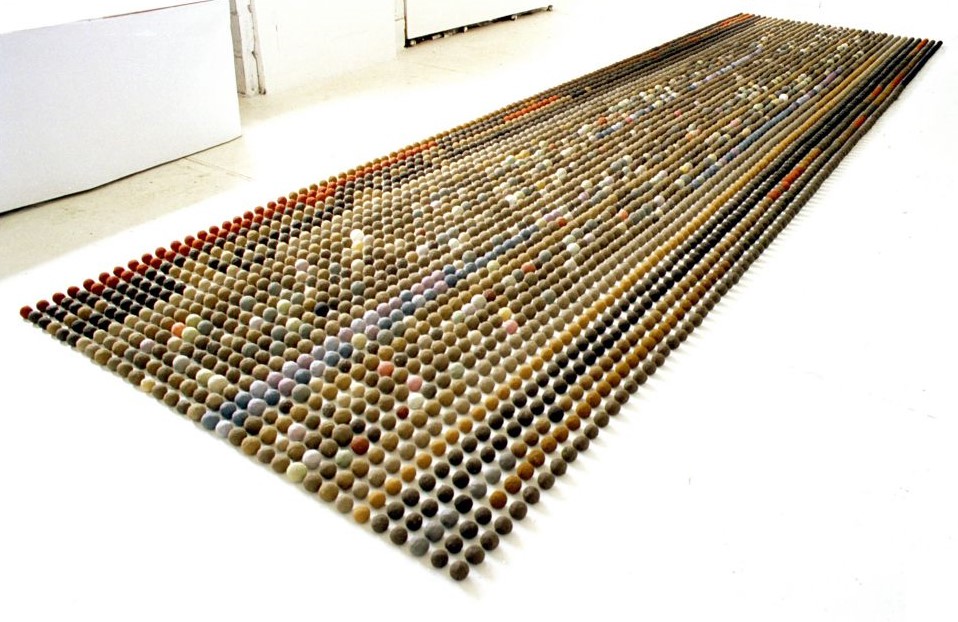
I then had a fruitful online dialogue with artist Stephen Turner who sent me some literature from one of his previous bodies of work. His email back to me included the statement below which encouraged me in a similar direction of leaving a trace of nature in my outcome. Reading Stephen’s words highlighted how he connects his body and soul to the landscape before he defines the art – nature fuels his thinking rather than the other way round. This was a key message that I took forward.
“I very much like the idea of taking the hubris out of art-making and letting nature’s own voice be heard.”
– Stephen turner
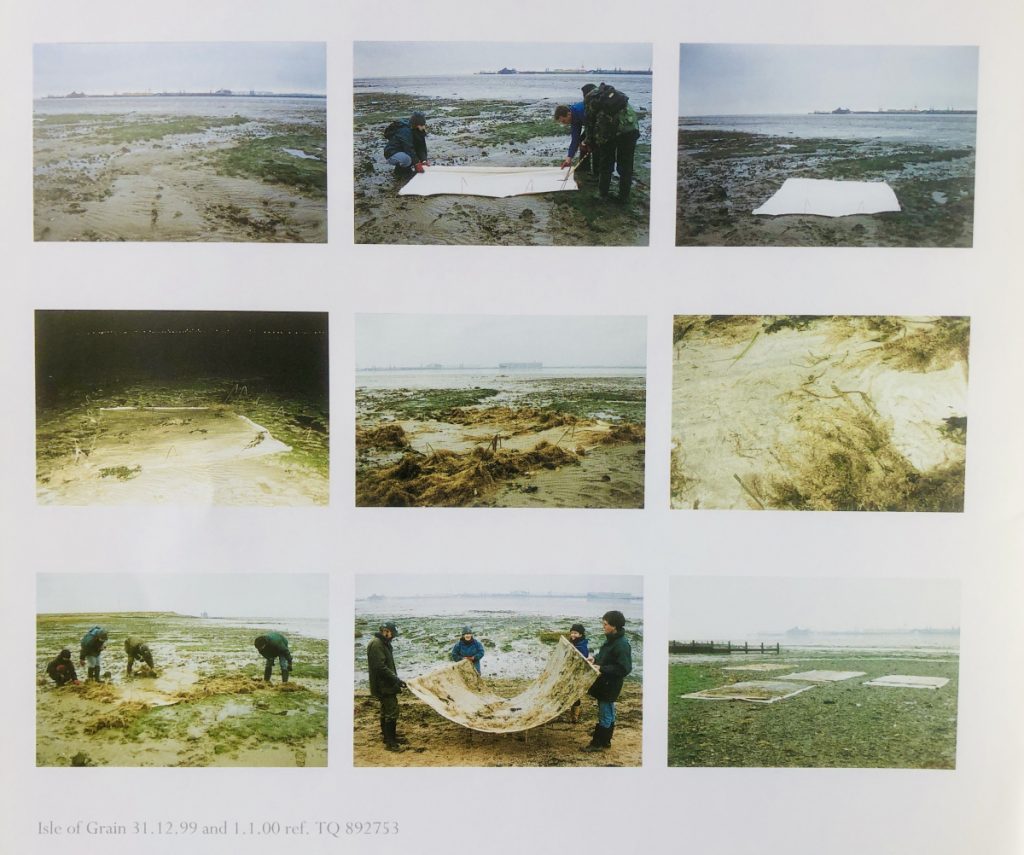
I then delved into the historical and contemporary work of kinetic artists that included looking at Man Ray and Johnny White as well as purely engineering challenges to create kinetic water structures. I found some innovative work but felt that this was deviating away from my theme and the engineering was dominating the outcome. However, the idea for waterwheels came out of this study so it was a useful diversion.
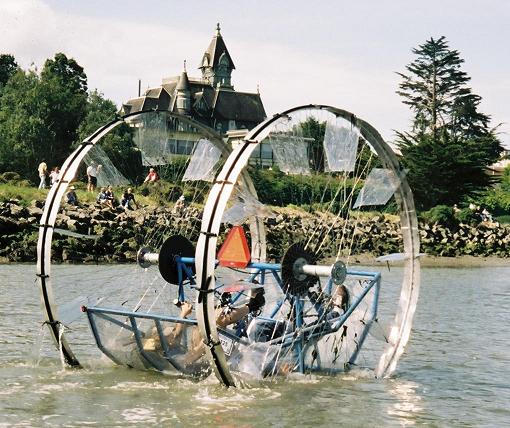
To gain a deeper understanding of art in the landscape I then looked at the land artists Richard Long, Hamish Fulton, Robert Smithson with a particular focus on exactly where the art lies with such work. Some of these artists leave their art in the landscape whereas others such as Richard Long, document their work in sublime ways for gallery viewing. This prompted my own decision as to whether define my art as a live event or a historical narrative.

When I was considering how to mount my installation I chose a number of mixed media installation artists: Christian Mayer, Lori Vrba and Janet Laurence. These were artists who specifically used photography to create a mixed narrative in their work. I was particularly informed by the work of Christian Mayer below, in how imagery was used in the exhibition space to enclose the viewer and ignite a historical narrative.
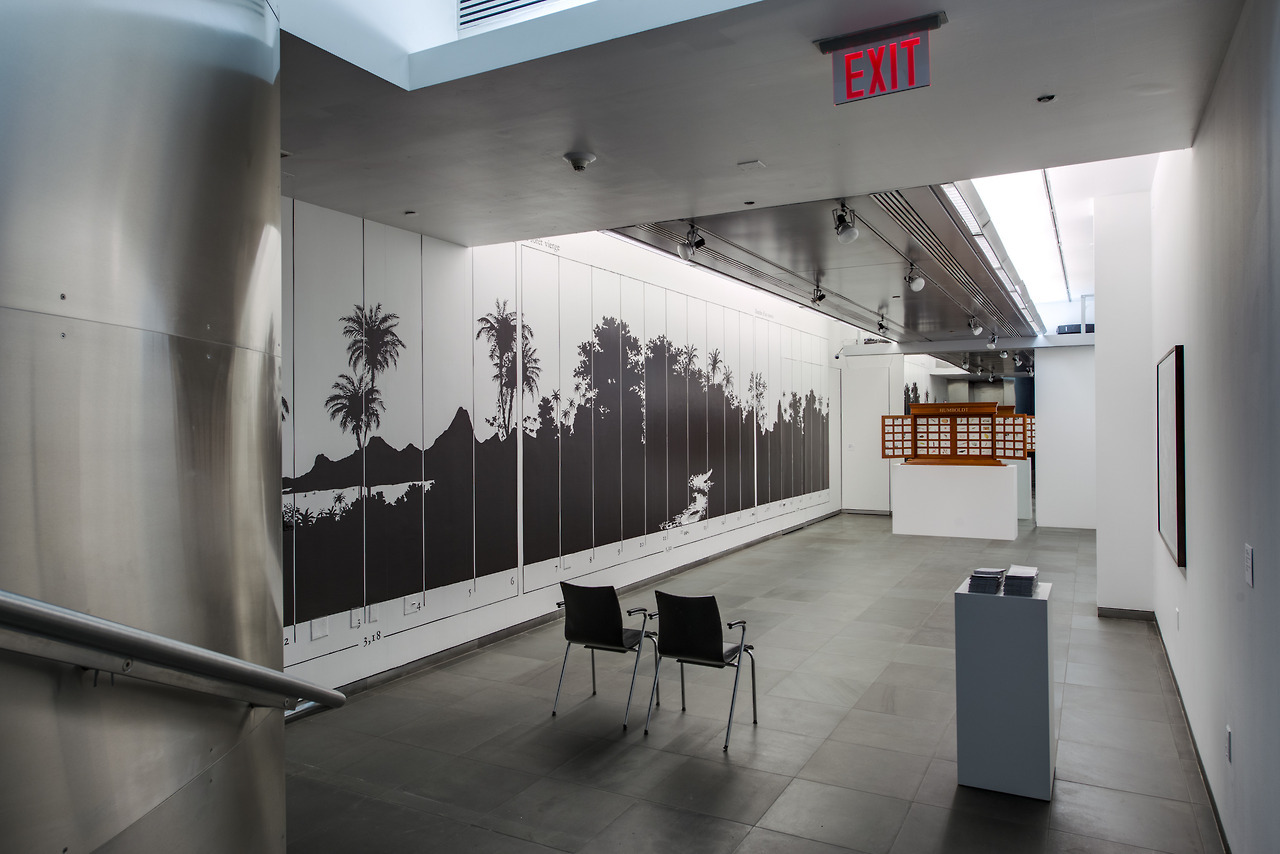
During the project, I was reading the work of Robert Macfarlane and was intrigued by the concept of counter-mapping which challenges the traditional concept of cartesian mapping. Counter maps don’t necessarily have north at the top, scale is unnecessary, can be 3D and the inclusion of history is imperative. This subversion of the system used by developers of a landscape created an explosion of ideas and fuelled my work with language on the project.
“Counter-mapping makes visible those aspects, psychological as well as geological, that we have sought to bury, suppress, hide, or render obscene. Such things have — in trauma theory as in geomorphology — a tendency to resurface.”
― ROBERT MACFARLAnE
Finally, I considered the work of the high profile artists Andy Goldsworthy & Olafur Eliasson as their environmental and experiential work had greatly inspired me first hand. I embraced how Goldsworthy works only with natural materials outside of the gallery walls but I also enjoyed how Eliasson tinkers with physics to expose simplistic aesthetic beauty. I believe my strategy has been to combine the ideas of both these major artists to reveal a tension between the natural and man-made and ask hard questions about man’s influence on the landscape of the Erewash Valley.
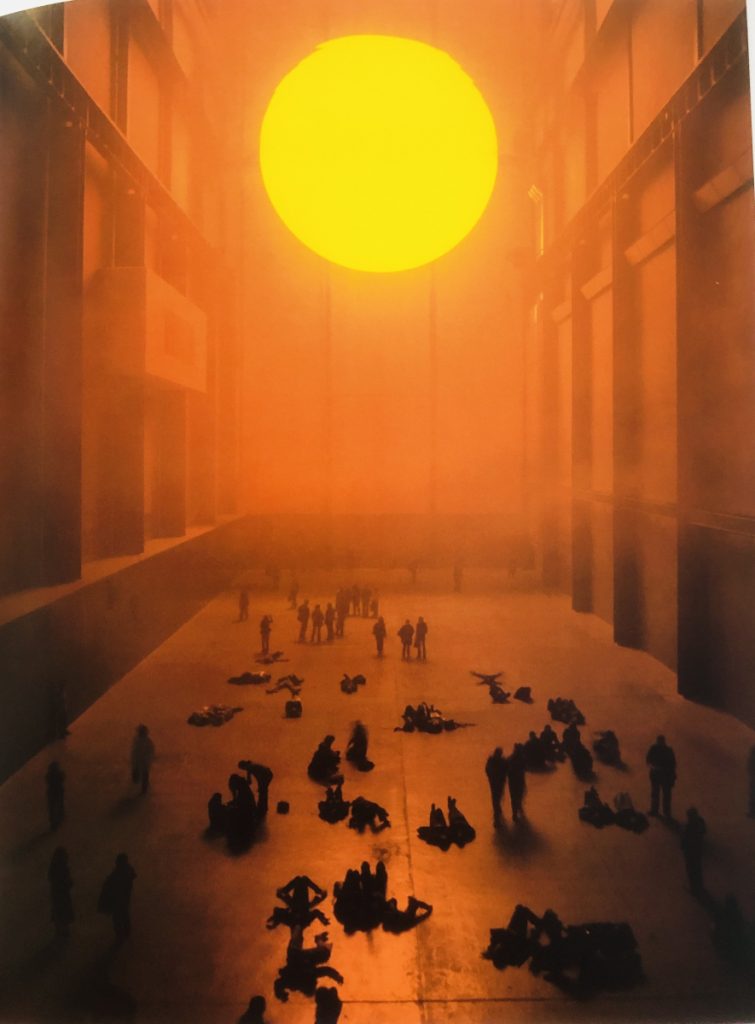
Experimental development
Many experiments were carried out during the project, progressing from video capture and hardware engineering to installation planning. They are all summarised below.
DH Lawrence get his lines crossed with HS2
My first visit to the river was on a cold winter’s day and I took a video camera, a script and a creative spirit. I wanted to sit by the river alone and absorb everything about it. To promote my thinking, I’d constructed a mashup of phrases from DH Lawrence’s The Rainbow and an HS2 consultation document. I found it fascinating that both these texts talked of the river 100 years apart and with very different motives. The awkward juxtaposition of these words appealed to my sense of humour and I had a feeling that words would play a central role in the project so I took that knowledge forwards. I also shared this early recording on social media and it received positive feedback so I thought I had already identified a unique angle to pursue.
Mud collection along the River Erewash
I then walked the full course of the river in 3 stages and collected mud samples from the river bed at 1-mile intervals, having been inspired by other artists I’d researched. It was fascinating how the river substrate changed from a reddish grit at its source to a dubious black in the lower stretches. A palette of colours had emerged which I stored as a record of the trip but as yet I wasn’t sure if this would play any part in my final piece as I’d deviated a little from my initial idea of using language in the project. However, this collection was a fascinating record of my journey and sparked more physical memories than an equivalent set of photographs would have done.
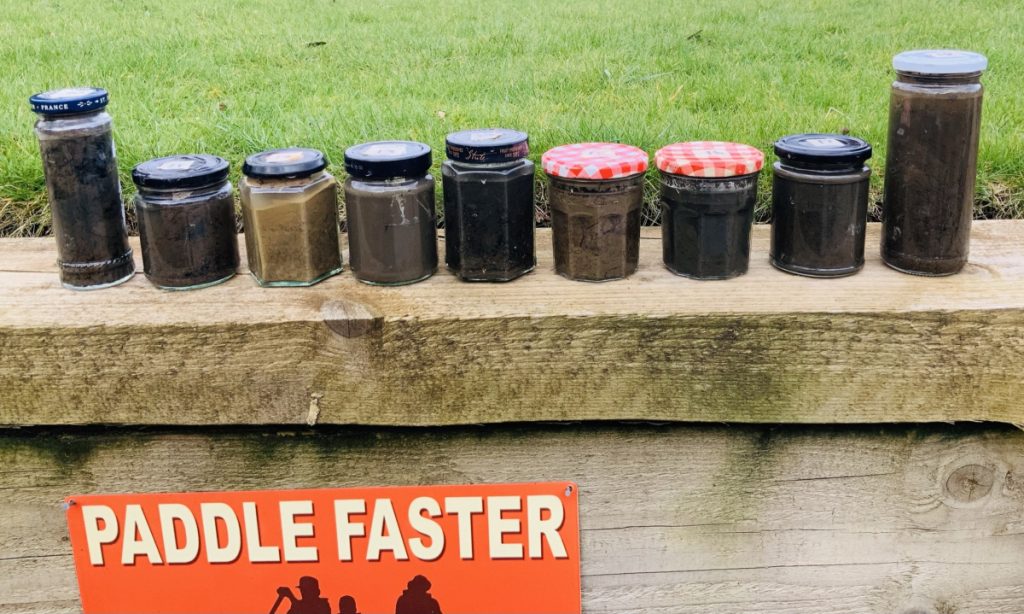
River Erewash Google reviews
On my second trip along the course of the river, I read out a set of selected Google reviews to explore the juxtaposition between that language and being in the landscape in and around the river. The idea of some of the most polluted stretches of the River Erewash being a tourist destination was ridiculous, but why not imagine that future? Though entertaining, this idea was not as pertinent as the DH Lawrence/HS2 readings so I thought of other readings I could make for the third trip.
Mud collection became a wine tasting tour
On my final walking trip, I read out selected wine tasting notes as I collected the mud samples. This was entertaining to carry out – holding such a distasteful piece of matter whilst reading about something that was exquisitely tasteful appealed once again to my sense of humour, but as for the previous video clips I seemed to have lost some of the potency of the earlier DH Lawrence/HS2 recordings.
16 shades of brown
At this stage, I examined the mud samples that I had obtained from the river to see if there was any potential for using them to create an artistic outcome in their own right. The consistency of the samples did vary quite a lot ranging from gritty brown rock to vegetation to fine black silt however, there didn’t seem to be enough colour variation to create an outcome that did justice to the journey I’d been on. However, I kept the samples as their inclusion in some form was still possible.
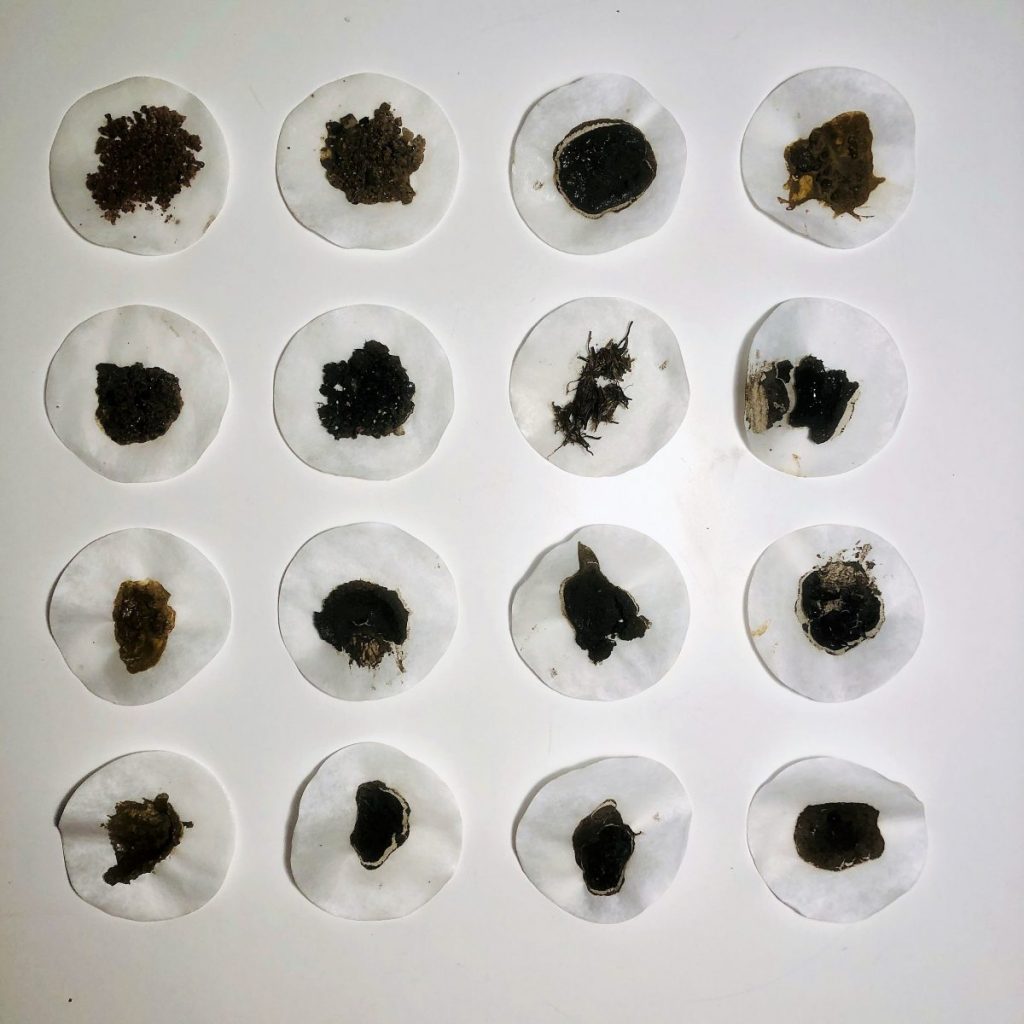
Planning for a river interruption
I then decided that I wanted to create some form of interruption of the river be that land art, or a record of an event. I looked back on my trips to see if there was a location that was well suited for this purpose and I found a stretch close to my home that flowed across at a wide grassy meadow that seemed ideal. A public path ran straight past the river so if I chose to make my work visible to the public this would be possible, so this location was physically explored. In reality, the location had a number of issues; access to both sides of the river was problematic and there was a fair amount of wildlife on that stretch. So I kept this location on hold and looked elsewhere for more suitable places for an installation.
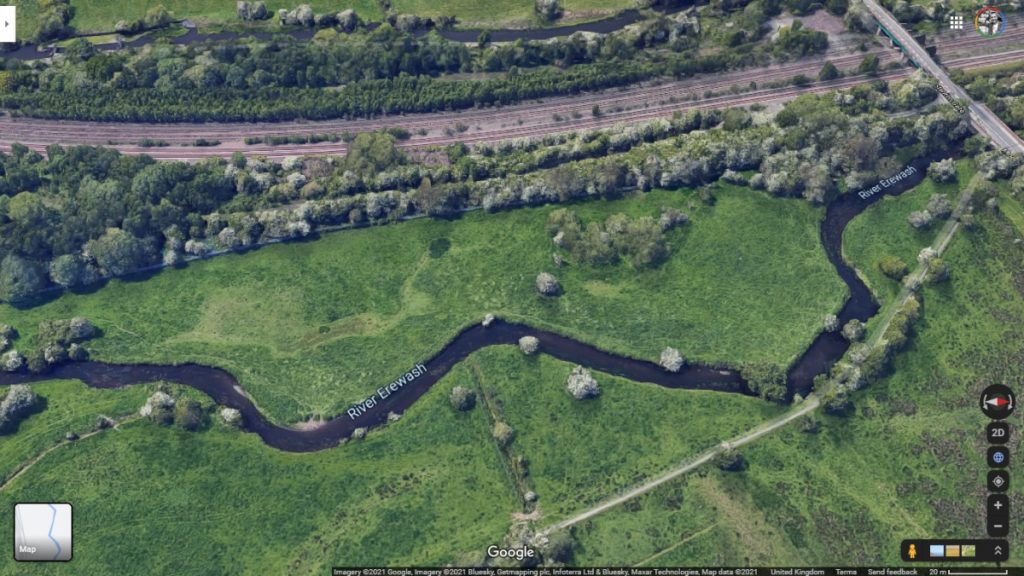
Words flowing together
A study of kinetic artists led me to the idea of creating a set of water wheels across the river so this experiment was a simple prototype to test the idea out. I created a set of four paddles attached to a spindle and placed this in the river to see if it would turn in the current. Each paddle had a word on it that was revealed as the paddles turned around and it worked well. There was clearly some work to be done on how to suspend the paddles over the water but this was positive progress and having carried out research this idea didn’t seem to have been used as an art form before. The paddles were suspended on a couple of sticks pushed into the riverbed however I needed to be able to deal with changing river levels so the project became an engineering task that was going to depend on using quality materials.
Plywood & swivel hook prototype
For this experiment, I constructed a single paddle using a wooden spindle and plywood and suspended it over the river using a nylon cord. I found that if I suspended it at the right height it would turn well, even in a slow current, however, I discovered that the nylon cord twisted instead of the spindle being turned which meant that as the line got taught, the paddles were lifted out of the water and stopped turning. Clearly, I needed a free-flowing axle that would allow the waterwheel to turn independently so more intricate engineering was required to achieve this.
Suspended waterwheel
I had a discussion with a civil engineer friend and we talked about the potential forces on more than one paddle across the river and how this may impact the ability of them to turn. Our conclusion was to have a higher line or even a solid bar across the river from which paddles could be suspended and float independently on the river surface. This would spread the forces out but also look more aesthetically pleasing if constructed well. This experiment tested that idea in principle and it was immediately more successful than the previous version. However, it became clear that paddle height above the water was going to be critical so I needed a way to finely adjust the paddle height above the water going forward.
A design for full-size water wheels
The time came to specify how many paddles I wanted to use in the installation and the dimensions they should be. I decided on five paddles as this seem to be appropriate for the width of the river given that the river was 5 m across and each paddle would be approximately 50 cm long to allow any text on them to be read from a good distance. I had a discussion with the 3-D department and the necessary hardware was ordered to allow the paddles to be constructed, which I did in my own workshop.
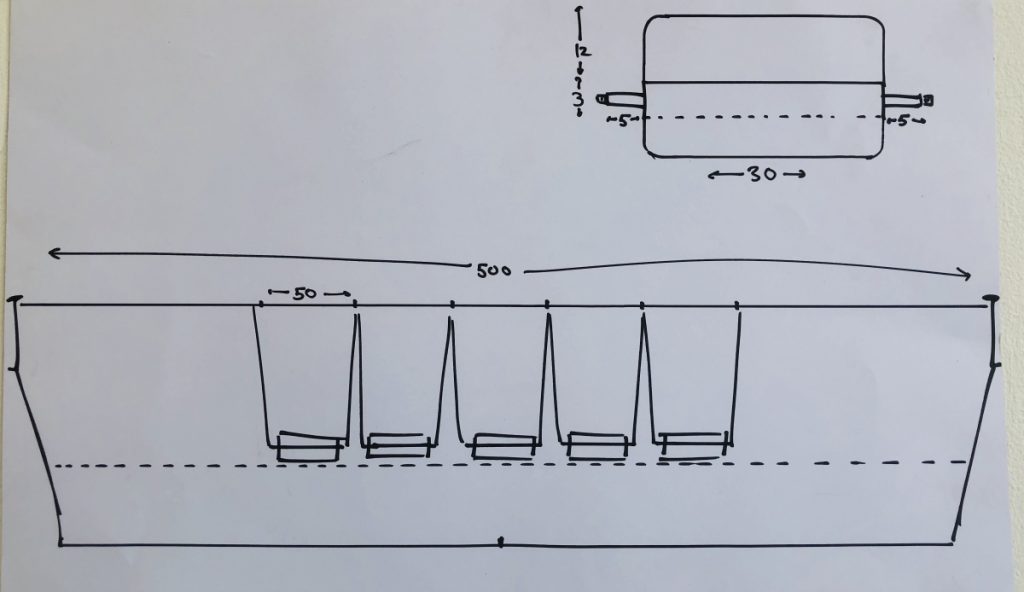
Two paddle prototype
One paddle now had to become two to see how they would turn together but also I used a steel cable and a solid hollow tube to suspend them in a line. Once again this was successful and I managed to adjust the height of the paddles above the water by tensioning the wire. I had also laser cut some sample text onto the paddles to test the readability of this from a distance. The installation was starting to take shape and my attention would now turn to the text and how / what to put on the paddles to perfectly crystallise the essence of the river in this one piece of work.
Font psychology and choice
Font choice was going to be critical as every font carries its own narrative and it had to enhance the writing not dampen it. So I evaluated quite a number of fonts and settled on a stencil font as I wanted the letters to be boldly cut out of the paddles and reflect on the water surface. The font I chose was Riks, as highlighted on the bottom piece of paper, which had a mild industrial aesthetic but was readable and contemporary at the same time.
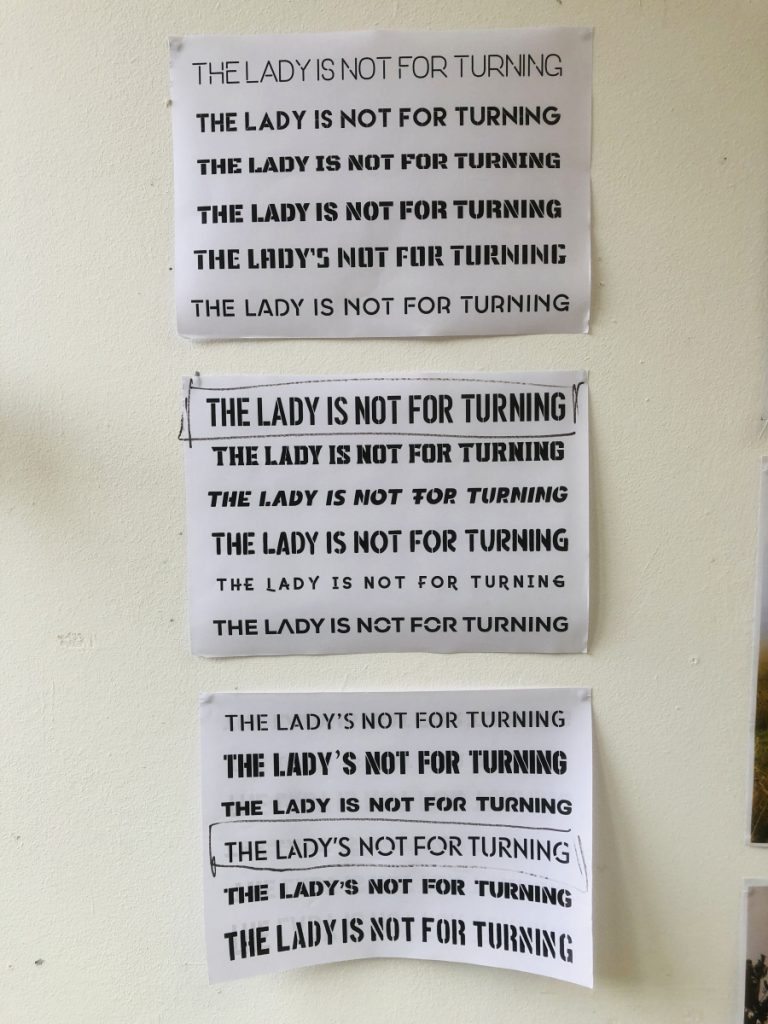
Finalising words for the paddles
Using JavaScript/jQuery coding I now experimented with different word combinations to see how the paddles would randomly create new combinations of words once they were let loose on the water. This was a useful exercise with minimal technical development and allowed me to discover all sorts of interesting combinations of language that I would otherwise not have anticipated.
I spent some time deciding on the actual words to laser cut onto the paddles. The final set of words are those being animated below and they explored the language used to describe the river from different geographical distances so I chose words issued by the central government, regional HS2, DH Lawrence, and the immediate environment of the river. Some intriguing combinations of words emerge as these animated paddles twist and turn together and I was happy with the level of abstraction I’d achieved.
Font laser cut problem
I had a slight hiccup with the first stencil font that I chose as some of the internal connections in the font were so narrow that the laser cutter destroyed them completely, hence some of the word parts fell out. Therefore I chose another stencil font with thicker connections that in retrospect was more appropriate for the purpose. It’s always interesting when a failure leads to a greater level of success.
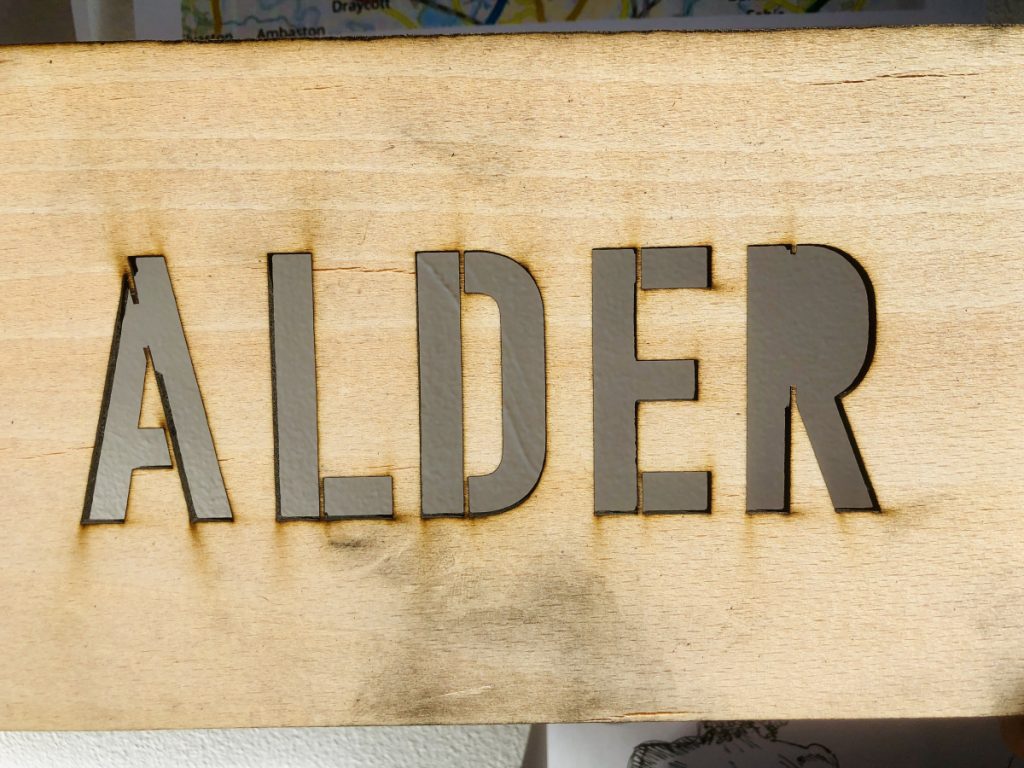
Finalising installation location
I considered once again where to install the paddles over the river and decided that a more secluded location would be more appropriate as I wasn’t going to make this a public installation, the event was going to be a private experience that I was going to document for the actual exhibition. I found a location near Trowell post office where the river moved across an open pasture and had a quiet long stretch with a bend in the river. The flow was smooth and there was no obvious wildlife around which was another consideration as I didn’t want to disrupt the environment from that perspective. There was also a footbridge to allow access to both sides of the river.
The final paddle build
I built the full set of 5 paddles in my workshop and used a single 2.5m length of hollow pipe to suspend them to ensure that they would all be maintained in a line across the river. The structure was balanced and had an affirmative architectural quality and the text was bold and readable so I was looking forward (if a little apprehensive) to placing this in the river.
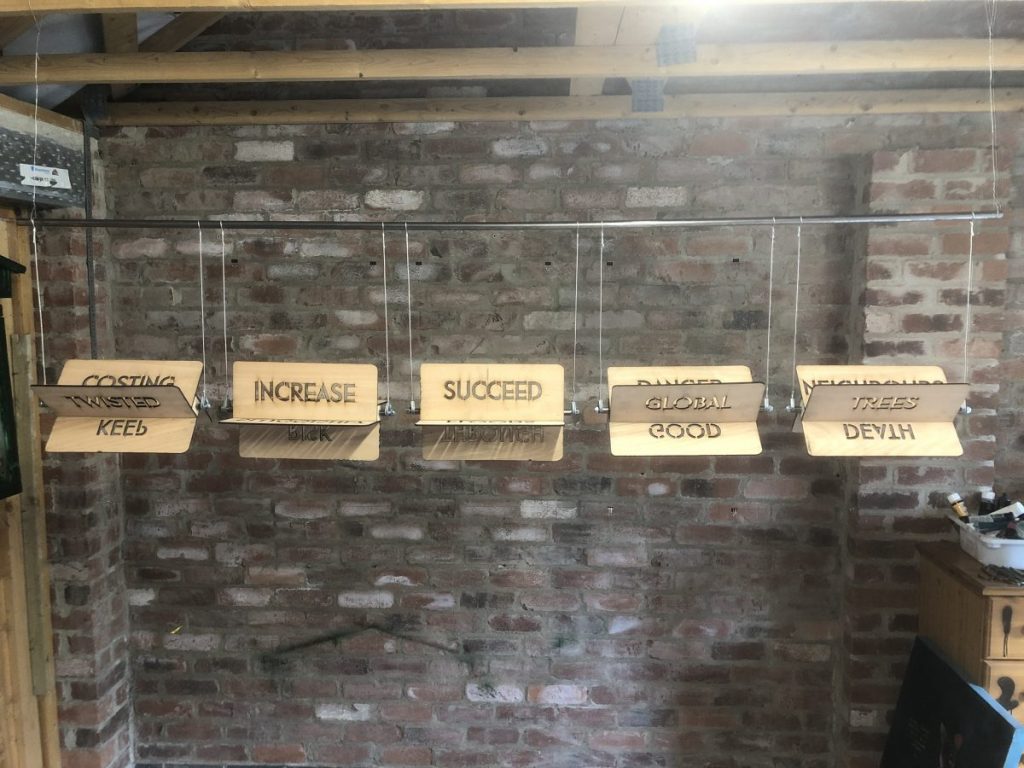
Planning the space
I was also thinking about how the piece would be represented in my exhibition. Showing the paddles in some form was critical but I needed a backdrop to add context so I started to experiment with sheets of material with words cut out of wood placed on them. It was fascinating that the letters that I chose to cut out of the paddles could be reimagined to create new words to place on the sheets as you can see. So I experimented with different combinations of words and replicated the course of the river on the sheets which created some interesting combinations that I was very happy with. I did explore the idea of using either a video or an overhead projector to show letters and words but this physical backdrop seemed to allow the paddles to rightfully dominate the installation so it was the preferred option.

Full waterwheel test
I had arranged for a CAA accredited drone pilot to film the paddles so two days before the event I carried out a full test and they turned beautifully. The key was to have them suspended at exactly the right height to ensure that they turned in the water but I also noted that they were turning at different speeds hence the word combinations were changing really well. I was ready for the actual installation to take place.
Postcard design
I am always keen on extending the viewer experience beyond seeing my work and the idea of a postcard to give more context seemed appropriate. Therefore I designed a simple postcard with the name of the project and a QR code to a video of the drone footage on one side, and a quote from DH Lawrence which inspired the start of this project on the other side. The colours on the front of the card were taken from the colours of the samples of mud obtained so I hoped that this simple takeaway would make the public think a little harder and longer about the challenges facing this river.
Photo choice for installation
Rather than show a video of the drone footage as part of the installation, I decided to show a set of simple black-and-white photographs to give evidence that the live event had taken place. A video would have dominated the experience and taken the viewer’s attention away from the paddles which were rightfully the essence of the project. The set of photographs below show the process of installing the paddles across the river and provide that extra bit of context for the viewer to make the link between what they will see in the exhibition and what has happened in the past.

Live event & drone filming
The day for the drone filming was chosen carefully so that it was a partially cloudy sky which created constantly changing dynamic shapes on the river surface. A slight issue was that the height of the water had changed therefore the first location where the paddles were installed meant that they failed to turn. So the wire was moved further upstream to a location where they started to turn. The location chosen was actually better than the original as it was on a bend which added more variation in river speed across the span hence the paddles turned at quite different speeds, which was exactly what I was hoping for. It was a fantastic experience to see my idea come to fruition and I took on board that moment to ensure the energy would carry forward to the later installation.
Planning the space #2
With the live event finished it was time to bring the paddles into the studio and judge how they would best sit within the installation booth I’d already set up. I decided on a vertical installation as this indicated that the paddles had been lifted out of the water. It was significant that the paddles had remnants of the river on them including staining and bits of water weed. The plywood of the paddles in front of the semi-transparent material created a good contrast and the buildings behind added an industrial aesthetic which I really liked. My final decision was to have the paddles taking centre stage in the booth with the set of photographs on one sidewall and the postcards sitting on a plinth on the other side. This separation gave the paddles breathing space, which they needed and it left the viewer to glance left and right to fill in the gaps in their understanding and make sense of what I was showing them.
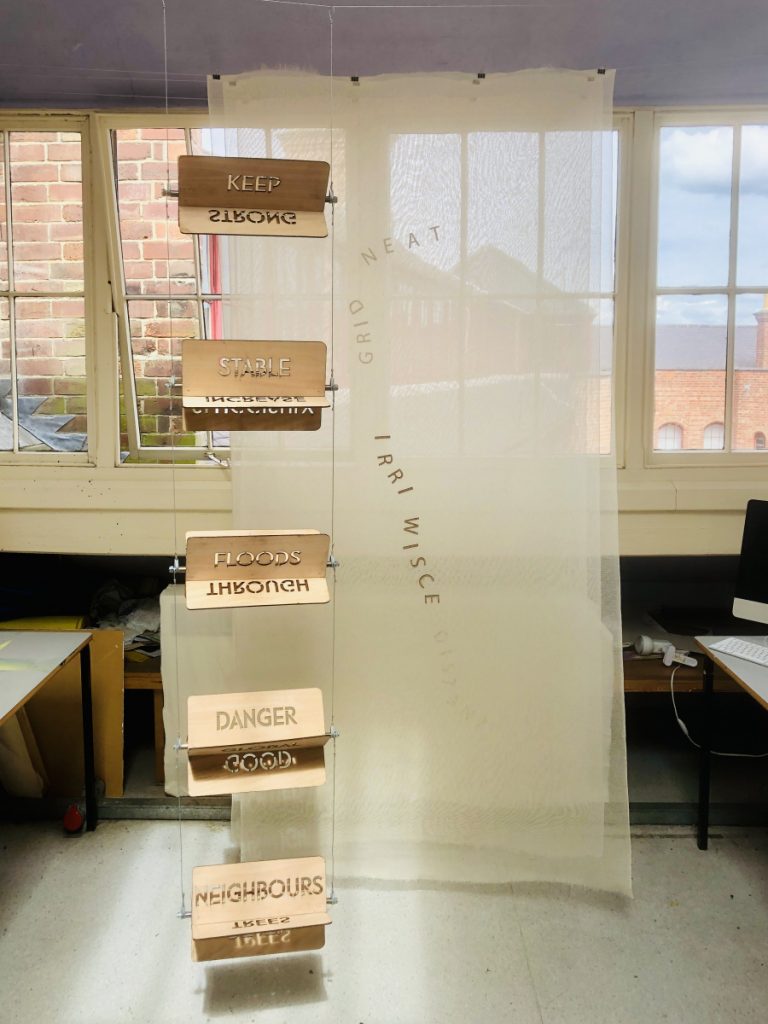
Evaluation
Project methodology
I gave this project the simple title of Irre Wisce, the Old English name for the River Erewash that paints a picture of a wandering wet meadow. If I’ve learnt one thing from my studies it’s that in art practice, simplicity usually carries more strength than fastidious detail and there’s something beautifully poetic about a river taking its name from the physical impact it has on the landscape it flows through. A slightly obtuse historical title forces a reflection on where we have come from, the thoughts and feelings of those guardians of the river who have passed before us and I hope it emphasises what we stand to lose. This title sets the stage by pointing a finger at the viewer and stating that they have a responsibility to honour the past and be protective of this precious natural environment against all the powerful forces that are eager to push it aside.
I have been shockingly aware of the threats to the Erewash Valley imposed by the proposed HS2 phase 2b route for many years, so this was a sociopolitical project from the outset. But as an environmentalist and artist who has experienced much environmental art I wanted to create an outcome that didn’t simply attack the forces behind development but rather, created deeper conversations about our connections and responsibilities to the landscape. My philosophy to changing hearts and minds is not doom and gloom but doom and bloom. We see too much negativity about our impact on the environment without a leading light for hope. That was my intention and through a combination of wry humour and poetic licence as part of a site-specific intervention, I hope I achieved this.
As I think back to the steps of experimentation on this project it differs from all others in that the idea behind my very first experiment (D H Lawrence/HS2 mashup video) has effectively been represented in the final outcome. Yes, it’s in a different mechanical form but the initial juxtaposition of poetic history and hard-headed capitalism is still there. So often in my previous projects, my early ideas have been consumed by ongoing tangents of discovery and not play a part in the final outcome. I’d like to think this is a sign of a more mature and confident approach to experimentation as I went all out with an abstract idea from the outset and was not satisfied with snapping scenic photographs of the river. Gut feeling in art practice is something I now respect so I clung to that early satisfaction I got from the video recording and it guided me towards a successful outcome.
Where the art resides
This project ventured far and wide geographically, historically, culturally and from a materials perspective which led to a raging internal debate (and with my peers) as to where the art would reside – would it be the live event on the river, would it be a video recording of the event, would it be a re-enacted performance or would it be a collection of artefacts as an installation? The decision came to fruition partly due to an email dialogue with artist Stephen Turner who creates site-specific work using natural materials, and this two-way discussion led me to make my work an installation that brought together the essence of an ephemeral event that took place in the landscape.
An ephemeral event made it plain that I wasn’t out to overpower nature as there is only one winner (and it’s not our species) but as Turner’s insightful quote below highlights, I wanted to absorb some of nature’s forces and bring them together as a relived experience. Yes, I’d created a framework and some rules but then nature has dealt the cards back to me using her hidden forces that we tend to ignore. Jeremy Deller has been another inspiration throughout my studies and I take on board his delight in letting go of a piece of work and letting fate take over. This is both thrilling and agonising but in this case, it was essential as the river had to speak back to me, make its mark and spit out the result.
“Nature is not on our side as it doesn’t take sides, only we do.”
– stephen turner
Ephemeral work also has a wider role in environmental awareness as it teaches us that not everything we value has to be material – a moment in time can be as precious as any glinting object. So maybe my viewers will be frustrated or confused when they see my work as they were not there, but I see that as a positive thing as I want them to question the concept of value in the world around them. If I can make them think again about the value of simply being in a place then that to me would be a significant result.
Language as a delivery vehicle
I chose language as the vehicle to deliver my message as words force the viewer to reflect. Clever wordplay paints pictures like no other media can and it can be used as a subversive form of political activism that the likes of Barbara Kruger and many others used to great effect. Slight changes in words can have a fundamental effect on meaning and purposely ambiguous words can leave gaps for devious antagonists to exploit. It was this ambiguity that I was interested in, particularly how individuals with different vested interests had represented the river through history in their own words.
As I dug deeper it started to fascinate me that language is the recording tool of both law and poetry but these outputs could not be more different. They both use the same words but it is the order that distinguishes them so I started to question how we recognise legal and poetic writing and this spurred all sorts of ideas including writing official documentation as poems.
My final outcome takes words that reference the river from different geographical distances from the location of the installation on the river. My enquiry looked at how language created further away from the river differs from that created close by and the results were blatant. My own inference is that when we are engrossed in a landscape our emotions sprinkle more poetic language onto our thoughts, we are visibly stimulated by nature and our right brain takes creative control. Contrast this with the left brain thinking of central government issued rhetoric and I need to say no more. The avenues of ideas I’ve explored here convince me that language was the most powerful and insightful device to use to represent the core of my project.
Material choice
I had access to a variety of materials from which I could have built the water wheels. I chose plywood, wire and a selection of metal hardware but I experimented with many other materials. The plywood was a beautiful material to work with and laser cutting resulted in a scorched edge to the letters which gave real power to the words – as if they had been burnt out with gusto. These were not apologetic words to take lightly but they had changed the course of history in many cases by scorching away what existed before. Historically, water wheels were wooden so I enjoyed that nod to the past. Practically, the paddles also had to float and turn in the water so the choice of plywood was confirmed as the best option.

The metal hardware was purchased from a variety of sources but I ensured it had a consistent polished silver appearance. The result is an affirmative structure that has real intent and is perfectly balanced. The nuts and bolts were a nod to the industrial past of the Erewash Valley, as factory machinery churned out products for export and pollution for disposal that flowed down the fated river for several hundred years. The bright metal hardware also glinted in the sun and looked awkwardly out of place in the natural environment, but the real delight was the audio I captured as it recorded the odd mix of birds singing and metalwork creaking together. This was a strange form of harmony that I didn’t anticipate but it was another juxtaposition that really worked and justified my choice of materials.
The viewer experience
My project resides in a large booth and consists of the vertically suspended paddles, a grid of 6 photographs showing the historical installation on the river and a set of postcards on a plinth. The paddles are hung vertically not only to fit the space but also because this delivers the idea that they are drip drying after being in the river, encrusted with the remnants of that experience. The viewer can walk around this structure, turn it, smell it and get a picture of the mishmash of word combinations that are possible. The paddles need space to breathe so they sit centrally in the booth as the main event – they are the culmination of my entire project so they must occupy centre stage, unhindered by interference.
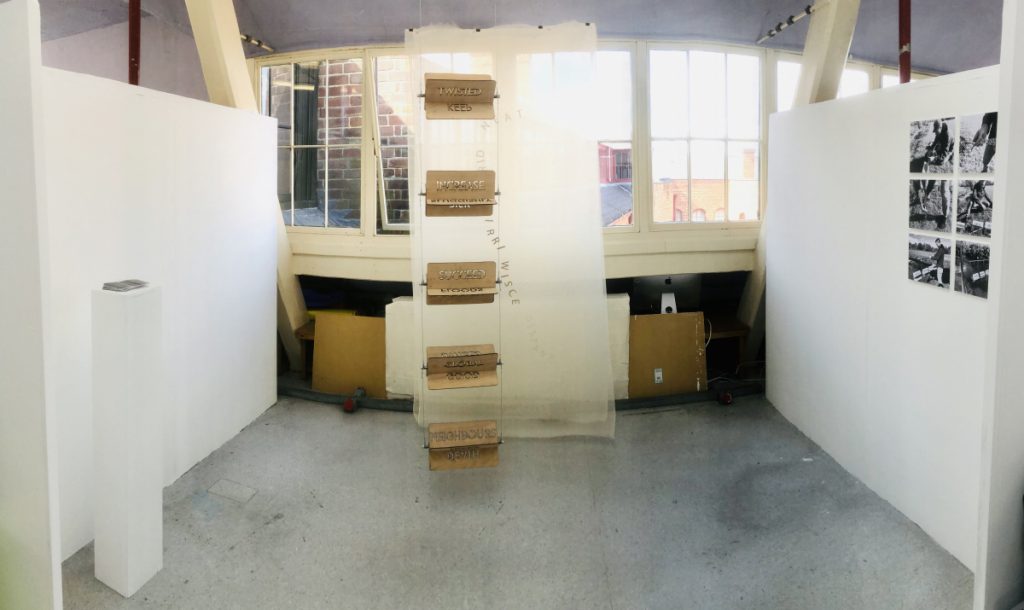
The backdrop to the paddles was important to add contrast and context but it was critical that they didn’t dominate the presentation. I experimented with a projection and a video but these both seemed to dominate the scene – I kept reminding myself that the project was about language, not fancy technology. Semi-transparent calico sheets provided the perfect backdrop as they diffused the view through the window but left a sense of the industrial scene, once again paying homage to the industrial past of the Erewash Valley. The same letters that were cut out of the paddles were scrambled to form new words that were stuck on the sheets and they worked magically – particularly how IRRE WISCE was formed together with GRID, NEAT and GONE. Placing the words on different sheets of material created depth, shadows and interesting perspective but also words on the furthest sheets were almost indistinct; like the real world, history stands to be forgotten unless we are reminded of it.
The photographs show 6 stages of the live event, from the construction of the paddles to them being on the river. They are black and white to indicate that a historical event has occurred. They an important reference point and the viewer must do some work to decipher the connection with the paddles. I purposely placed the photographs a good distance from the suspended paddles as I like the notion that a viewer will glance between them and the physical installation and get that moment of satisfaction when they connect history with their reality.
The postcards are a takeaway that I want viewers to keep and further reflect on what they have experienced, and as with the photographs they are positioned away from the paddles so as not to interfere with them. They show a simple trace of the river, a set of vertical bars with colours taken from the mud samples I collected and a QR code linking to the drone video footage. After much thought, I decided to exclude the drone footage from the actual installation as I believe it would have dominated inappropriately. Video technology is pervasive and indicative of ignorance of genuine experience so it had no place in my physical work but was an important record of the event that would hopefully ignite further interest in the future. I am always keen on extending the viewer experience beyond a physical visit so these postcards are intended to do just that. On the reverse of postcards is a line from DH Lawrence’s The Rainbow that references the River Erewash. It was this phrase that started me on this journey so by showing this last of all I’m taking the viewer back in time, reminding them that history is alive and we should never take language at face value.
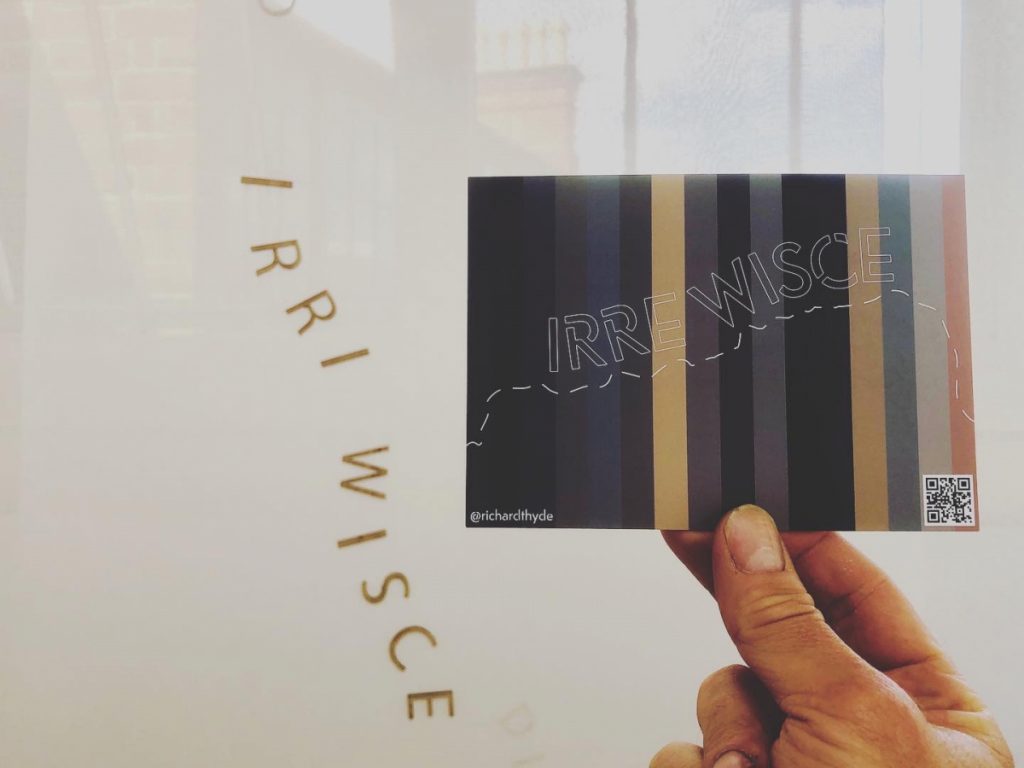
Future potential
This project explored the entire stretch of a river with a rich history, cultural heritage and political battleground so as I anticipated it would open up countless pathways for further artistic outcomes. In fact, a challenge throughout was to keep a focus on my original concept but this was greatly assisted through regular peer critique. A number of the most promising ideas for development are explored below.
Public interruption of the river
I chose to make the interruption of the river a private event but at an earlier point considered making it an open public experience, including extending invites to the local Erewash Museum and the DH Lawrence Museum. The challenges in doing this are the legality of the installation on the river and the impact on wildlife if it was left in place for an extended period. However, given suitable conditions (i.e. winter) a public event would be an exciting opportunity to engage with the public on the river, gather their stories, their concerns and possibly secure collaborations with other individuals and bodies with an equal passion for the Erewash Valley. The installation would simply be a meeting point and it would be the public who generated the content as a record of this interruption. Video recordings of visitors talking about the river would provide a valuable asset that then becomes an outcome in its own right. Of all the future potential of this project, this public event would be the most fruitful as I believe there is a huge quantity of unspoken history of the River Erewash that needs to be aired.
Counter map of the Erewash Valley
I briefly explored the idea of counter-mapping during the project, having been inspired by the words of Robert MacFarlane. This fascinating idea challenges the dispassionate nature of the cartesian mapping system and suggests that history, language and culture have as valid a part to play in any record of a place. Understandably, developers throw scorn at any non-mappable environmental features so this makes counter-mapping even more powerful fuel for an artist. A counter map of the river valley would completely reimagine the landscape and could be a sonic experience, a set of ceramic tiles each telling a story or even a walking tour of the valley with performances. I have already been in communication with my local parish council and given them a proposal to create a parish map (effectively a counter map of our local area) which they are very interested in. This would be an opportunity to apply for funding if it gathers sufficient momentum and create a permanent record that helps protect the local Erewash heritage.
Water powered installation
When studying kinetic art I came across a number of waterwheels that generated power and even though this was beyond the scope of my project I did think it might be an intriguing development. I can imagine a set of single paddles powering lightbulbs along a stretch of the river as from a distance this would be a beautiful sight and if the stretch was chosen carefully the twists and turns of the river would be dots of light at night. A set of lights could also be put behind a set of opaque Perspex letters that were vertically aligned along the river. The lights would illuminate the letters which formed words along the river bank. This project would extend the installation beyond a single location as single words could be spread over a larger area and from a distance, the scale of the river would take on a new meaning. The notion of what a river actually is can be debated and the idea of generating energy from the flow adds a new dimension to the simple flow of water.

